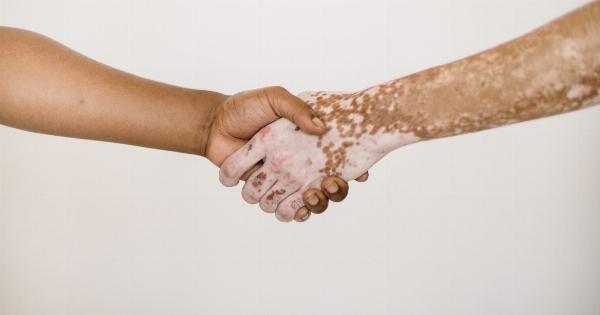Every year, on June 29th, the European Scleroderma Support Group organizes the European Day for Awareness to shed light on the rare but debilitating disease called scleroderma.
This important event aims to educate the public about the condition, raise funds for research, and provide support for those affected. By standing up to scleroderma, we can unite as a community to make a difference in the lives of patients and their families.
What is Scleroderma?
Scleroderma, also known as systemic sclerosis, is a chronic autoimmune disease that affects the connective tissues in the body.
It is characterized by abnormal growth of collagen, a protein that provides structure and support to various organs and tissues. This excessive production of collagen leads to hardening and tightening of the skin and internal organs.
Scleroderma can vary in severity from person to person, with symptoms ranging from mild to life-threatening. The disease primarily affects women between the ages of 30 and 50, but men and children can also develop it.
While the exact cause of scleroderma remains unknown, researchers believe that a combination of genetic and environmental factors may contribute to its development.
Types of Scleroderma
Scleroderma manifests in two main forms: localized scleroderma and systemic scleroderma.
Localized Scleroderma
Localized scleroderma mainly affects the skin and occasionally the muscles and bones. There are two subtypes:.
1. Morphea
Morphea appears as oval-shaped patches of thickened skin that are typically reddish or purplish in color. Eventually, these patches turn white and feel hard or woody to the touch.
Morphea is often limited to specific areas of the body, such as the arms, legs, or face.
2. Linear Scleroderma
Linear scleroderma refers to a band of hardened skin that typically affects the limbs, forehead, or scalp. In some cases, this subtype can also impact underlying muscles or bones, leading to limb-length discrepancies or joint contractures.
Systemic Scleroderma
Systemic scleroderma affects not only the skin but also internal organs, such as the digestive system, heart, lungs, and kidneys. There are two main types:.
1. Limited Cutaneous Systemic Sclerosis
In limited cutaneous systemic sclerosis, the skin involvement is limited to the hands, face, feet, and lower arms. Other organs may be affected, but the disease progression is generally slower compared to the diffuse cutaneous subtype.
2. Diffuse Cutaneous Systemic Sclerosis
Diffuse cutaneous systemic sclerosis affects a larger area of the skin, often extending to the trunk and thighs. It can progress rapidly and lead to more significant internal organ involvement. This subtype has a higher risk of complications.
Symptoms and Complications
The symptoms of scleroderma can vary widely depending on the type and affected organs. Here are some common signs and complications of the disease:.
1. Skin Changes
Thickening and hardening of the skin are hallmark symptoms of scleroderma. The skin may become shiny, tight, and difficult to move. It can also become itchy, discolored, or develop ulcers and sores.
2. Raynaud’s Phenomenon
Raynaud’s phenomenon is frequently associated with scleroderma. It causes the fingers and toes to turn white or blue in response to cold temperatures or emotional stress. As blood flow returns, affected areas may throb, tingle, or become red.
3. Gastrointestinal Issues
Scleroderma can affect the muscles in the esophagus, causing difficulty swallowing (dysphagia) and heartburn. It may also lead to bloating, constipation, or diarrhea due to impaired motility in the intestines.
4. Lung Involvement
Almost half of all systemic scleroderma patients will experience some degree of lung involvement. This can lead to shortness of breath, coughing, and reduced lung function over time.
5. Kidney Problems
In some cases, scleroderma can affect the kidneys, leading to high blood pressure, fluid retention, and possible kidney damage. Regular monitoring of kidney function is crucial for early detection and management.
6. Cardiac Complications
Scleroderma can cause inflammation and scarring of the heart, leading to arrhythmias, chest pain, and heart failure. Regular cardiac evaluations are essential for early intervention and treatment.
Diagnosis and Treatment
Diagnosing scleroderma can be challenging due to its varied symptoms and the absence of specific diagnostic tests.
A combination of medical history, physical examination, blood tests, imaging studies, and skin biopsies may be used to confirm the diagnosis.
While there is no cure for scleroderma, various treatment options are available to manage symptoms, prevent complications, and improve quality of life. The treatment plan may include:.
1. Medications
Medications are used to control symptoms such as acid reflux, Raynaud’s phenomenon, and inflammation. Immunosuppressants may also be prescribed to reduce the overactive immune response in systemic scleroderma.
2. Physical Therapy
Physical therapy plays a crucial role in managing scleroderma symptoms. It can help improve joint mobility, reduce muscle stiffness, and increase overall physical function.
3. Occupational Therapy
Occupational therapy focuses on adapting daily activities to reduce joint stress and improve functionality. It helps individuals maintain independence and cope with any limitations caused by scleroderma.
4. Lung and Heart Treatments
Lung involvement and heart complications require specialized treatment. Depending on the severity, treatments may include oxygen therapy, medication, or even lung transplantation in extreme cases.
5. Emotional Support
Living with scleroderma can be emotionally challenging. Support groups, therapy, and counseling can provide invaluable mental and emotional support for patients and their families.
The Importance of Awareness
Scleroderma is a rare disease, and thus, many people are unfamiliar with its impact on individuals and communities. The European Day for Awareness aims to change that by raising awareness through various initiatives and events across Europe.
By increasing awareness, we can help reduce the time it takes for patients to get a correct diagnosis and receive appropriate care. Early intervention is key in managing the symptoms of scleroderma and preventing complications.
Moreover, raising awareness allows us to advocate for better resources, funding, and support for scleroderma research. The more we understand the disease, the closer we get to finding effective treatments and, ultimately, a cure.
Get Involved: Standing Up to Scleroderma
There are numerous ways to show your support and get involved in standing up to scleroderma:.
1. Spread the Word
Share information about scleroderma on social media, in your community, or among friends and family. Use the hashtag #StandUpToScleroderma to help raise awareness and connect with others.
2. Participate in Events
Look for local events organized by scleroderma support groups or foundations. These events can include walks, runs, fundraisers, or educational seminars.
Participating in such events not only helps raise funds for research but also shows support for patients and their families.
3. Volunteer Your Time
Contact local scleroderma organizations and inquire about volunteering opportunities. You can contribute your skills, time, or resources to help organize events, raise funds, or support patients and their families directly.
4. Donate
If you can, consider making a donation to reputable scleroderma organizations or research foundations. Your contribution can make a significant difference in supporting ongoing research efforts and improving the lives of those affected.
5. Educate Yourself
Take the time to learn more about scleroderma, its symptoms, and the challenges faced by individuals living with the disease. The more knowledge you possess, the better equipped you are to support and advocate for those impacted by scleroderma.
Stand Up to Scleroderma Today
On the European Day for Awareness, let us all stand up to scleroderma together.
By increasing awareness, supporting research, and lending a helping hand to those affected, we can make a lasting impact on the lives of scleroderma patients and their loved ones. Take action, spread the word, and be a part of the fight against this debilitating disease.




























